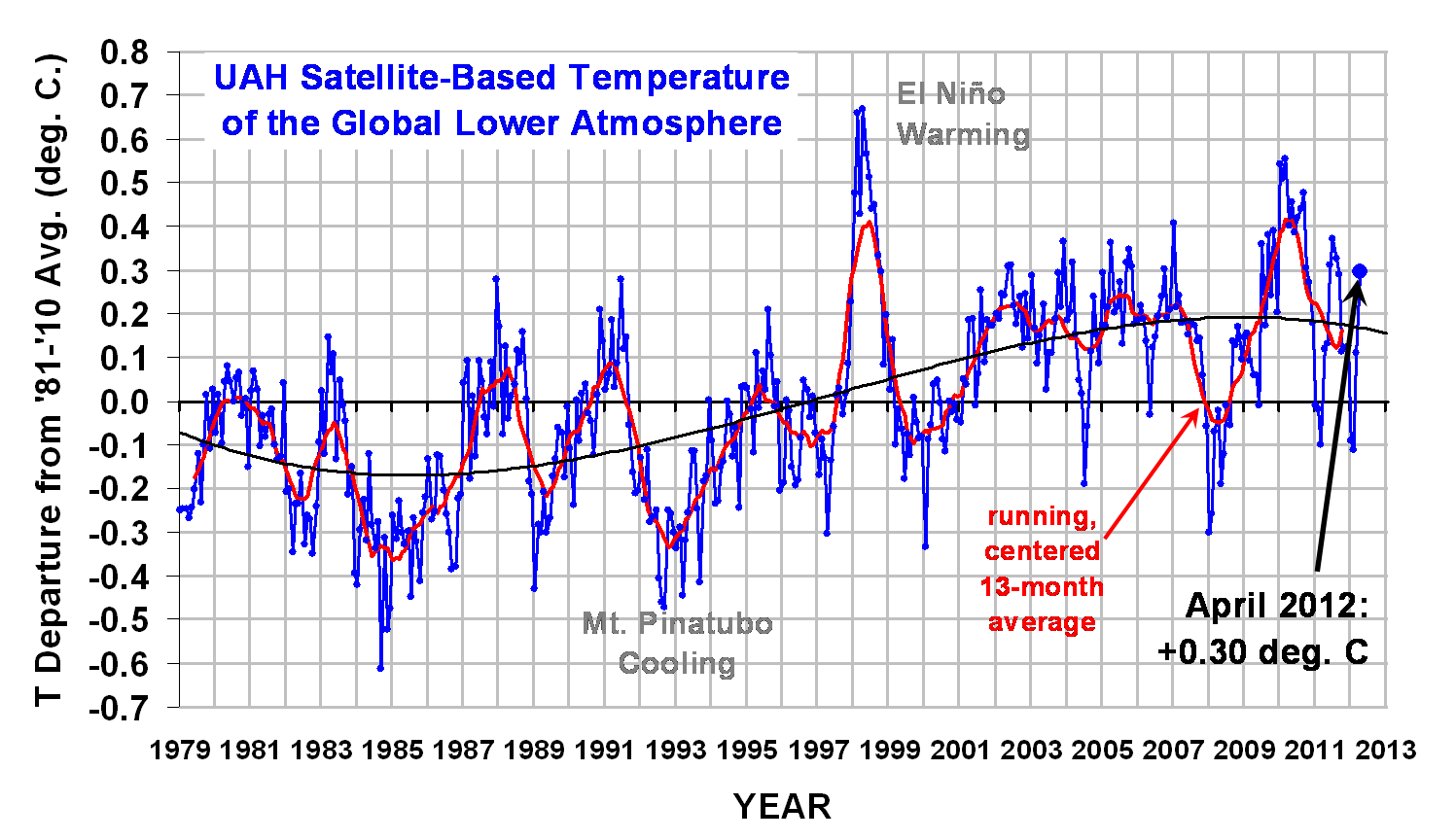There have been a number of posts and comments about James Hansen's op ed in the NYTimes,
featured here at Rabett Run, and of course, many other places. As Eli predicted, the key graph for those in disagreement was
The global warming signal is now louder than the noise of random weather, as I predicted
would happen by now in the journal Science in 1981. Extremely hot
summers have increased noticeably. We can say with high confidence that
the recent heat waves in Texas and Russia, and the one in Europe in
2003, which killed tens of thousands, were not natural events — they
were caused by human-induced climate change.
As he said then Eli's POV on this is rather simple. If you have natural variability on
top of a rising base, then the hotter extremes are going to get hotter
and you don't need a degree in meteorology or statistics to figure that
out, so the Bunny is with Hansen. If you want to argue that it is going
to cool like crazy Roy in the next decade, well, good luck with that,
but Eli has a slightly used Sky Dragon to sell you.
Andy Revkin, in particular was keen to go out and find disagreeers, in particular Martin Hoerling from NOAA, and Marty did disagree
This is patently false. Take temperature over the U.S. as an example.
The variability of daily temperature over the U.S. is much larger than
the anthropogenic warming signal at the time scales of local weather.
Depending on season and location, the disparity is at least a factor of 5
to 10.
I think that a more scientifically justifiable statement,
at least for the U.S. and extratropical land areas is that daily weather
noise continues to drum out the siren call of climate change on local,
weather scales.
Dot Earth arranged a further, more
formal exchange of position papers between Hoerling and Dan Miller who worked with Hansen on the op ed. As usual, Eli encourages all to RTFRs, but here he wants to call attention to Hansen's brief comment
I have several papers well along in the publication process that make
clear your characterizations are far off the mark. The editors prefer,
indeed are insistent, that I not discuss these in blogs. Some scientists
may be able to spend their time blogging and e-mailing without a
significant impact on their scientific productivity — I’m not one of
them — but I do make an effort to make my papers understandable to a
wide audience.
Dan Miller's paper at Dot Earth and Kate, over at
Climate Sight, drew Eli's attention to
Public Perception of Climate Change and the New Climate Dice by Hansen, Sato and Ruedy which was posted to arXiv April 5, so perhaps this is not one of the papers Hansen was specifically referring to, but phrases in the abstract show that it clearly bears.
"Climate dice", describing the chance of unusually warm or cool seasons
relative to climatology, have become progressively "loaded" in the past 30
years, coincident with rapid global warming. The distribution of seasonal mean
temperature anomalies has shifted toward higher temperatures and the range of
anomalies has increased. An important change is the emergence of a category of
summertime extremely hot outliers, more than three standard deviations
(3{\sigma}) warmer than climatology. This hot extreme, which covered much less
than 1% of Earth's surface in the period of climatology, now typically covers
about 10% of the land area. It follows that we can state, with a high degree of
confidence, that extreme anomalies such as those in Texas and Oklahoma in 2011
and Moscow in 2010 were a consequence of global warming, because their
likelihood in the absence of global warming was exceedingly small. We discuss
practical implications of this substantial, growing, climate change.
The manuscript is there to be read, off you go little bunnies, but Eli wants to look at a key figure.
The authors examined the distribution of local anomalies using the 1951-1980 base period using local standard distributions. This was also done for the Northern Hemisphere alone, and for other base periods. The areas under each curve are normalized. The black curve is a Gaussian and it should be noted that the 1951-61and 1961-71 distributions are slightly more peaked, with slightly less area in the cold and hot wings, in other words there are fewer extremes.
On the other hand (kenw that was coming didn't ja) with time after 1971, the distributions shift to hotter temperatures, and the shift increases with time, good additional evidence that global warming is continuing, but more importantly, the distributions noticeably broaden and the wings grow significantly. Whereas before 1971 the probability of a 3 σ event was zilch, today it is well above the base line.
But wait, there is more. Eli as an old curve eyeballer thought there were something funny about the purple curve and tried to fit it to a gaussian.

and sure enough, the fit is fine up to the peak, but on the hot side the blue Gassian is much lower than the observed frequency of hot anomalies beyond about 1 σ This shift from symmetric Gaussian to skewed hot anomalies is as, if not more important for addressing the issue of whether extreme hot spells are meteorology or climatology.
Although Hansen, Sato and Ruedy have not discussed the skew, they have looked simply at the implications of the anomaly distributions and this explains their confidence about the source of the extreme summer anomalies
Seasonal-mean temperatures in the category defined as "cold" in 1951-1980 climatology (mean temperature below -0.43σ), which occurred about one-third of the time in 1951-1980, still occur with a probability about 10% over land areas. Thus an occasional unusually cool winter is not evidence against global warming. Temperature is less "noisy" in the summer than winter. The chance of summer falling in the "hot" category of 1951-1980 is now about 80% (Fig. 7). The climate dice are now loaded to a degree that the perceptive person (old enough to remember the climate of 1951-1980) should recognize the existence of climate change.
The most important change of the climate dice is the appearance of a new category of extremely hot summer anomalies, with mean temperature at least three standard deviations greater than climatology. These extreme temperatures were practically absent in the period of climatology, covering only a few tenths of one percent of the land area, but they have occurred over about 10% of land area in recent years. The increased frequency of these extreme anomalies, by more than an order of magnitude, implies that we can say with a high degree of confidence that events such as the extreme summer heat in the Moscow region in 2010 and Texas in 2011 were a consequence of global warming. Rahmstorf and Coumou (23), using a more elegant mathematical analysis, reached a similar conclusion for the Moscow anomaly.
It is not uncommon for meteorologists to reject global warming as a cause of these extreme events, offering instead a meteorological explanation. For example, it is said that the Moscow heat wave was caused by an atmospheric "blocking" situation, or the Texas heat wave was caused by La Nina ocean temperature patterns. Certainly the locations of the extreme anomalies in any given case are related to specific weather patterns. However, blocking patterns and La Ninas have always been common, yet the large areas of extreme warming have come into existence only with large global warming. Today's extreme anomalies occur because of simultaneous contributions of specific weather patterns and global warming.
Martin Hoerling has a hard walk back.


















“When I look at this data, the trend is perfectly in line with a temperature increase of 6 degrees Celsius (by 2050), which would have devastating consequences for the planet,” Fatih Birol, IEA’s chief economist told Reuters.
It’s not in Birol’s slides, and not in his transcript. And it doesn’t make sense.